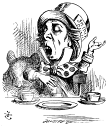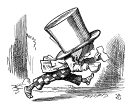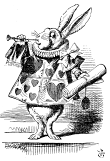Search us!
Search The Word Detective and our family of websites:
This is the easiest way to find a column on a particular word or phrase.
To search for a specific phrase, put it between quotation marks. (note: JavaScript must be turned on in your browser to view results.)
Ask a Question! Puzzled by Posh?
Confounded by Cattycorner?
Baffled by Balderdash?
Flummoxed by Flabbergast?
Perplexed by Pandemonium?
Nonplussed by... Nonplussed?
Annoyed by Alliteration?

Don't be shy!
Send in your question!
Columns from 1995 to 2006 are slowly being added to the above archives. For the moment, they can best be found by using the Search box at the top of this column.
 If you would like to be notified when each monthly update is posted here, sign up for our free email notification list.
If you would like to be notified when each monthly update is posted here, sign up for our free email notification list.
Trivia
All contents herein (except the illustrations, which are in the public domain) are Copyright © 1995-2020 Evan Morris & Kathy Wollard. Reproduction without written permission is prohibited, with the exception that teachers in public schools may duplicate and distribute the material here for classroom use.
Any typos found are yours to keep.
And remember, kids,
Semper Ubi Sub Ubi
|
Mmmph?
Dear Word Detective: Shortly after the birth of my nephew, my sister-in-law informed the family that she did not want his pacifier to be referred to as a “binky.” That got me wondering where the term came from in the first place and then how it became a common term for a baby’s pacifier. — J. Smith.
Hmmph. Kids are hopelessly spoiled these days. When I was an infant, we didn’t have any fancy-schmanzy “pacifiers.” If we wanted something to gnaw on, we got off our duffs and found a nice twig, and we turned out just fine. Besides, last time I checked, the human hand comes with a dandy built-in pacifier. I still use mine at tax time.
I am intrigued as to why your sis-in-law doesn’t want people calling her sprog’s pacifier a “binky.” If it’s because she finds the term insufferably cutesy and cloying, I’m with her all the way.
The pacifier in its modern form of a plastic or rubber nipple attached to a ring or shield (to prevent the child from swallowing the gizmo) dates to the early 20th century, but the use of similar devices to calm an upset infant is probably as old as upset infants themselves. Evidently in the 19th century it was common practice to give the child a ball of linen cloth wrapped around a lump of sugar or, a bit disturbingly, meat or fat, sometimes soaked in brandy. According to Wikipedia, teething toys in 17th century England were often made of coral. Yum.
I was surprised to learn that “Binky” is actually a trademarked term owned by Playtex, which registered it in 1935. But as a generic term for the device, “binky” is substantially older, and the word “binky” itself has a history apart from pacifiers. The Dictionary of American Regional English (DARE) lists “binky” as a folk term used in western Indiana as of 1912 to mean “any little mechanical contrivance,” and the word seems to have been in use for many years as a name for anything small and either inconsequential or cute. “Binky” is, for instance, popular as both a name for small dogs and a jocular nickname for men.
So, does “binky” actually mean anything? My guess is no. There is a Scots dialect word “bink” meaning “bench” or “shelf,” but I can’t imagine a connection to the way “binky” is used today. My guess is that “binky” is an onomatopoeic formation, a word whose sound conjures up a mental image, in this case of something small, not terribly important, but fun to have around.
Yuckarootie.
Dear Word Detective: I haven’t been able to find an etymology for the word “sleazy.” can you help? — Jon.
Sure, that’s what I’m here for. I mean “to help,” not “for sleazy,” of course. Then again, since you found me on the internet, you’ve no doubt already stumbled on more “sleazy” than any sane person can stand. I actually wrote a column on “sleazy” many years ago, but that was before the internet and sleaze-on-demand cable TV (not to mention pole-dancing classes at the local Y) made “sleaze” truly a household word, so we’ll give it another go.
I was going to venture my own bespoke definition of “sleazy” to kick off the festivities, but, as is so often the case, my imagination can’t hold a candle to that of the Oxford English Dictionary (OED): “Dilapidated, filthy, slatternly, squalid; sordid, depraved, disreputable, worthless.” I remember, back when Monica Lewinsky was on every front page, getting a call from a newspaper asking me to write an article about the lurid terms that were being used to describe the scandal. Now I’m thinking I should simply have referred them to the hyperventilating folks at Oxford.
Given the vehemence of that definition, it’s a bit disappointing that the OED notes that “sleazy” is “of uncertain origin,” especially since they note that the term has, in the past quarter-century, spawned such useful forms as “sleazeball,” “sleazebag” and “sleaze factor” (“Mr. Meese … had become the outstanding symbol of the so-called ‘sleaze factor’ which has bedeviled the Reagan administration,” 1983).
While it is true that there is no absolutely proven explanation of the origin of “sleazy,” there is a reasonable and frequently-made argument that ties the word to Silesia, a historically important region of Central Europe that today lies mostly within Poland (with small bits falling inside the Czech Republic and Germany). In the 17th century, Silesia produced fine cloth esteemed all over Europe, and in England “Silesia” was used as a general term for high-quality linen or cotton cloth. Over time, “Silesia” in this sense was shortened to “sleazy,” and cotton cloth became known as “sleazy cloth.”
Although “sleazy cloth” made in Silesia was of high quality, by the second half of the 17th century, “sleazy” had taken on the meaning of “thin or flimsy,” perhaps because by then merchants were selling all kinds of junk labeled “sleazy.” In any case, “sleazy” quickly came to be applied to anything characterized by inferior construction, shoddy materials, or flimsy reasoning (“Their vain, and sleasy opinions about Religion,” 1648). Interestingly, the “filthy and squalid” sense of “sleazy” didn’t appear until the 1940s, and “sleaze” as a noun meaning “a person or thing of low moral standards” didn’t arrive until the late 1960s.
But I’m good at bingo!
Dear Word Detective: I am a confessed crossword puzzle addict. Recently, I noticed both “canny” and “uncanny” as clues in the same puzzle. Well trained by your writings, I immediately recognized this as another example of “un-” words that don’t mean the negation of the apparent root. The question then arises, were the words originally related? — Ray.
That’s a darn good question. Incidentally, as a crossword puzzle addict, you’re made of sterner stuff than I am. People assume that I must love crossword puzzles, but I don’t, for the simple reason that I stink at them. Faced with a crossword more challenging than those found in Highlights for Children, my mind immediately erases itself and I am left with the vocabulary of a hedgehog. The funny thing is that if someone sits across the room and asks me the clues, I can often answer with no problem. Go figure.
You’re absolutely justified in suspecting that the “un” in “uncanny” doesn’t necessarily mean “not.” It’s ironic that the one “rule” of English word-formation that everyone knows so often turns out to be misleading. True, prefixes such as “un,” “dis,” “in” and “de” usually do signify negation of the root word (as in “disintegration,” something becoming less integrated, i.e., coming apart). But once in a while they actually act as intensifiers (as in “disgruntled,” meaning “very gruntled,” “gruntled” being an archaic word meaning “cranky”) or end up meaning nothing at all (as in “inflammable,” meaning essentially the same thing as “flammable”).
In the case of “canny” and “uncanny,” the “un” does, in fact, mean “not,” but both words have traveled far enough from their original meanings to make them not exactly opposites. “Uncanny,” in other words, means a bit more than simply “not canny.”
“Canny” is a very cool word. It first appeared in Scots and Northern English dialects as an adjective meaning “knowing, judicious, prudent, cautious,” and is simply based on the verb “can” in the sense of “to be able” (as in “I can fly”). “Canny” was picked up by English writers in the 17th century, who applied it to the Scots themselves in the sense of “cunning,” “wily” or “thrifty,” in line with the English portrayal of Scots as clever and frugal. The sense of “sharp” and “shrewd” eventually became more generalized, and today we use “canny” to mean “perceptive and wise” (“The canny investor avoids market fads”).
One of the other meanings of “canny” back in Scotland in the 16th century, however, was “trustworthy,” and when “uncanny” first appeared it was in the sense of “malicious or incautious” (i.e., not trustworthy). By the 18th century, “uncanny” had come to mean specifically “not safe to trust because of connections to the supernatural,” and eventually the word took on its modern meaning of “supernatural,” “weird” and “strange.” So “uncanny” came to mean something quite different than simply “not smart.”
|
Makes a great gift! Click cover for more.  
400+ pages of science questions answered and explained for kids -- and adults!
FROM ALTOIDS TO ZIMA, by Evan Morris
 
|


 can be found
can be found 




Recent Comments